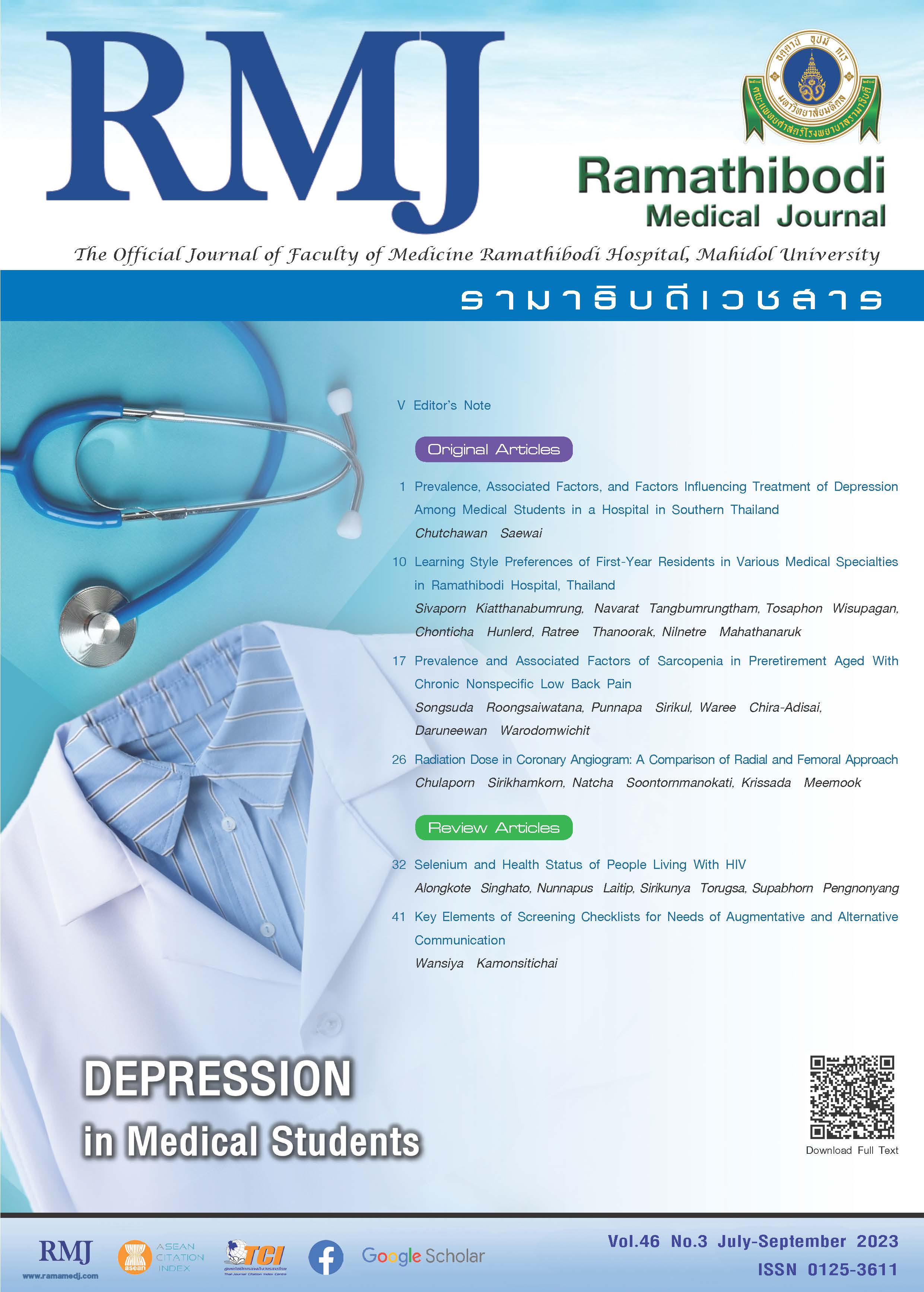Learning Style Preferences of First-Year Residents in Various Medical Specialties in Ramathibodi Hospital, Thailand
DOI:
https://doi.org/10.33165/rmj.2023.46.3.263199Keywords:
Medical resident, Learning preferences, VARKAbstract
Background: Learning styles preferences play an important role in helping learners acquire knowledge. Because each individual establishes different learning styles, knowing students’ learning preference may help instructors design appropriate teaching methods which aids students to achieve learning outcome more effectively.
Objective: To determine the learning styles in first-year residents of various medical specialties, using the VARK model.
Methods: This cross-sectional descriptive study recruited all first-year residents of academic year 2021 to 2022, at Ramathibodi Hospital. Ninety-five residents gave their consent and submitted the VARK questionnaire. The results were classified into 3 groups of specialties, based on its major characteristics being surgery-based, cognitive-based, or diagnostic-procedure-based.
Results: The VARK preferences in the surgery-based group were as followed; 7.9% aural learners, 26.3% kinesthetic learners, and 65.8% multimodal learners, with none being visual and read/write learners. In the cognitive-based group, the VARK preferences were 7.7% visual learners, 19.2% aural learners, 3.8% read/write learners, 19.2% kinesthetic learners, and 50.0% multimodal learners. In the diagnostic-procedure-based group, the VARK preferences were 8.3% visual learners, 37.5% kinesthetic learners, and 54.2% multimodal learners with none being aural and read/write learners.
Conclusions: The VARK preferences showed that Ramathibodi’s overall first-year residents were mostly multimodal learners with the surgery-based and the diagnostic-procedure-based groups having more kinesthetic preference learners in their specialties.
References
Yang FY, Chen YC. Learner preferences and achievement. In: Seel NM, ed. Encyclopedia of the Sciences of Learning. Springer; 2012:1750-1754. doi:10.1007/978-1-4419-1428-6_636
Fleming ND, Mills C. Not another inventory, rather a catalyst for reflection. To Improve the Academy. 1992;11(1):137-155. doi:10.1002/j.2334-4822.1992.tb00213.x
Leite WL, Svinicki M, Shi Y. Attempted validation of the scores of the VARK: learning styles inventory with multitrait-multimethod confirmatory factor analysis models. Educ Psychol Meas. 2009;70(2):323-339. doi:10.1177/0013164409344507
Panambur S, Nambiar V, Heming T. Learning style preferences of preclinical medical students in Oman. Oman Med J. 2014;29(6):461-463. doi:10.5001/omj.2014.120
Sarabi-Asiabar A, Jafari M, Sadeghifar J, et al. The relationship between learning style preferences and gender, educational major and status in first year medical students: a survey study from Iran. Iran Red Crescent Med J. 2014;17(1):e18250. doi:10.5812/ircmj.18250
Almigbal TH. Relationship between the learning style preferences of medical students and academic achievement. Saudi Med J. 2015;36(3):349-355. doi:10.15537/smj.2015.3.10320
Balasubramaniam G, Indhu K. A study of learning style preferences among first year undergraduate medical students using VARK model. Education in Medicine Journal. 2016;8(4):15-21. doi:10.5959/eimj.v8i4.440
Ojeh N, Sobers-Grannum N, Gaur U, Udupa A, Majumder MAA. Learning style preferences: a study of pre-clinical medical students in Barbados. J Adv Med Educ Prof. 2017;5(4):185-194.
Ahsan A, Talat N, Fayyaz S. Exploring the preferred learning styles among undergraduate medical students and postgraduate residents by using VARK inventory. Health Professions Educator Journal. 2020;3(1):24-30. doi:10.53708/hpej.v3i1.99
Kim RH, Gilbert T. Learning style preferences of surgical residency applicants. J Surg Res. 2015;198(1):61-65. doi:10.1016/j.jss.2015.05.021
Kim RH, Kurtzman SH, Collier AN, Shabahang MM. The learning preferences of applicants who interview for general surgery residency: a multiinstitutional study. J Surg Educ. 2016;73(6):e136-e141. doi:10.1016/j.jsurg.2016.06.013
Kim RH, Viscusi RK, Collier AN, et al. Learning preferences of surgery residents: a multi-institutional study. Surgery. 2018;163(4):901-905. doi:10.1016/j.surg.2017.10.031
Eosakul ST, Wong V, Ku CM, Mitchell JD. Learning preferences of first-year anesthesiology residents during their orientation month: a single-institution study. A A Pract. 2019;12(3):88-92. doi:10.1213/XAA.0000000000000880
Hassanzadeh S, Karimi Moonaghi H, Derakhshan A, Masoud Hosseini S, Taghipour A. Preferred learning styles among ophthalmology residents: an Iranian sample. J Ophthalmic Vis Res. 2019;14(4):483-490. doi:10.18502/jovr.v14i4.5457
Turner DA, Narayan AP, Whicker SA, Bookman J, Mcgann KA. Do pediatric residents prefer interactive learning? Educational challenges in the duty hours era. Med Teac. 2011;33(6):494-496. doi:10.3109/0142159x.2010.542524
Downloads
Published
How to Cite
Issue
Section
License
Copyright (c) 2023 Ramathibodi Medical Journal

This work is licensed under a Creative Commons Attribution-NonCommercial-NoDerivatives 4.0 International License.

















